A Private Tour today in North Norfolk, to start off the New Year. The aim would be to try to catch up with some of our lingering winter rarities and scarcities, along with as many other species as possible in between. It would require a quickfire series of stops up and down the coast. At least the weather gods were shining on us today – it was dry, bright and sunny at times.
As we drove west, a Barn Owl was still out hunting over a field beside the road – always a good start to the day. We headed straight across to NW Norfolk and parked on the verge just north of Sedgeford.
There was already a small crowd gathered and, even better, they were already watching the Eastern Yellow Wagtail. It was feeding out in the middle of the field with a couple of Pied Wagtails, and we got the scopes straight on it. It was a bit distant, but we all had a quick look at it before it took off. We watched it fly across the field and it seemed to be heading for its favoured muck heap, on the concrete pad further down the track, so we walked down to see if we could find it there.
There was no sign of the wagtail at the muck heap, so we scanned the field from here to see if had landed somewhere down this end. There were lots of Fieldfares feeding out in the middle and a flock of Linnets around some tufts of vegetation. A single Pink-footed Goose looked a bit lonely and one Pied Wagtail along the edge of the field had not brought any friends with it. A flash of yellow further down turned out to be several Yellowhammers which were flying in and out of the hedge, down to feed on the field margin.
Then someone spotted the Eastern Yellow Wagtail again, very distantly back on another muck heap in the field by the main road. We walked back up the track, but by the time we got back there it had disappeared round the rear, out of view. When the two Pied Wagtails it was with took off, the Eastern Yellow Wagtail flew too. We watched it fly down over the track and drop towards the muck heap where we had just been looking. It was really giving us the run around!
Back down the track, and as we approached the concrete pad again, we heard it call and noticed it feeding on the edge of the field right in front of us. It flew up calling – a distinctive buzzy ‘dzzzeep’ – across the track and landed again on the concrete pad, where it started feeding around the puddles. Now we had a great view of it through the scope.
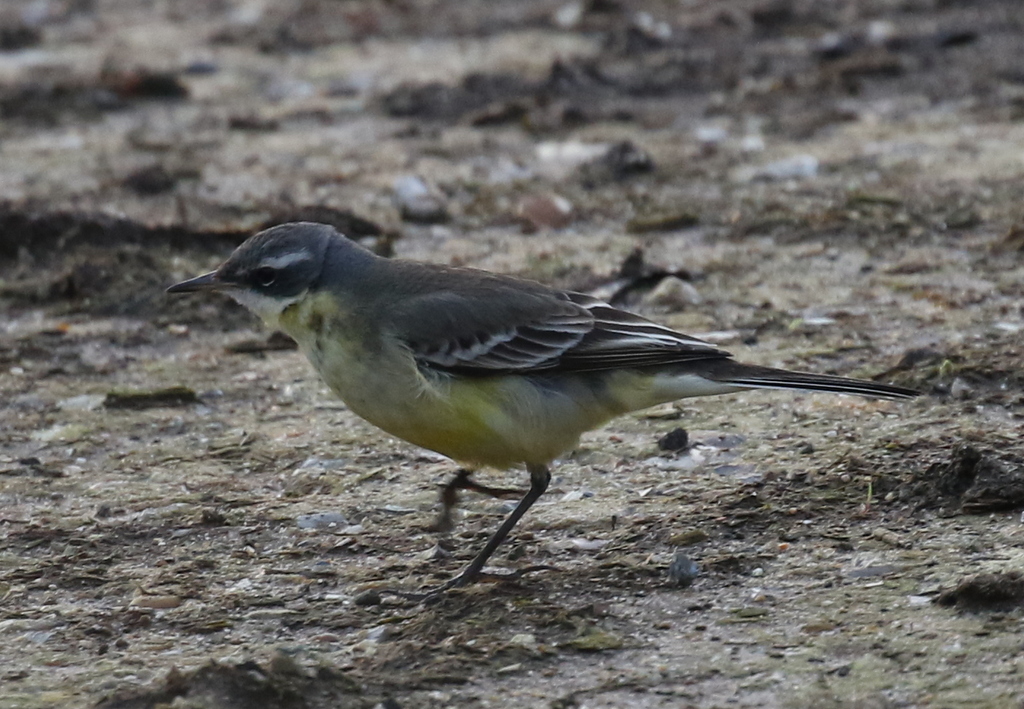
Eastern Yellow Wagtail is (logically!) the eastern counterpart to our Western Yellow Wagtail. They were all historically treated as a series of subspecies, but the eastern ones have a noticeably more buzzy call than the western ones and have consistent differences in DNA which are sufficient to see it elevated to full species status. It was therefore good that we heard it call.
This particular bird is unusually bright – most of the Eastern Yellow Wagtails which are identified in the UK are plain grey and white first winters. The grey head and white supercilium identify it as belonging to the subspecies ‘tschutschensis’, which breeds across eastern Siberia across to western Alaska, wintering mainly in SE Asia. It is a long way from home. And it is the first confirmed record for Norfolk (although several have been suspected in the past).
We decided to move on, and headed further south down to Fring. There had been a large flock of Pink-footed Geese feeding on a recently harvested sugar beet field just south of the village for the last couple of days. There were still quite a few there today – perhaps less than there had been, although more birds were arriving as we stood and started to scan through the huge throng.
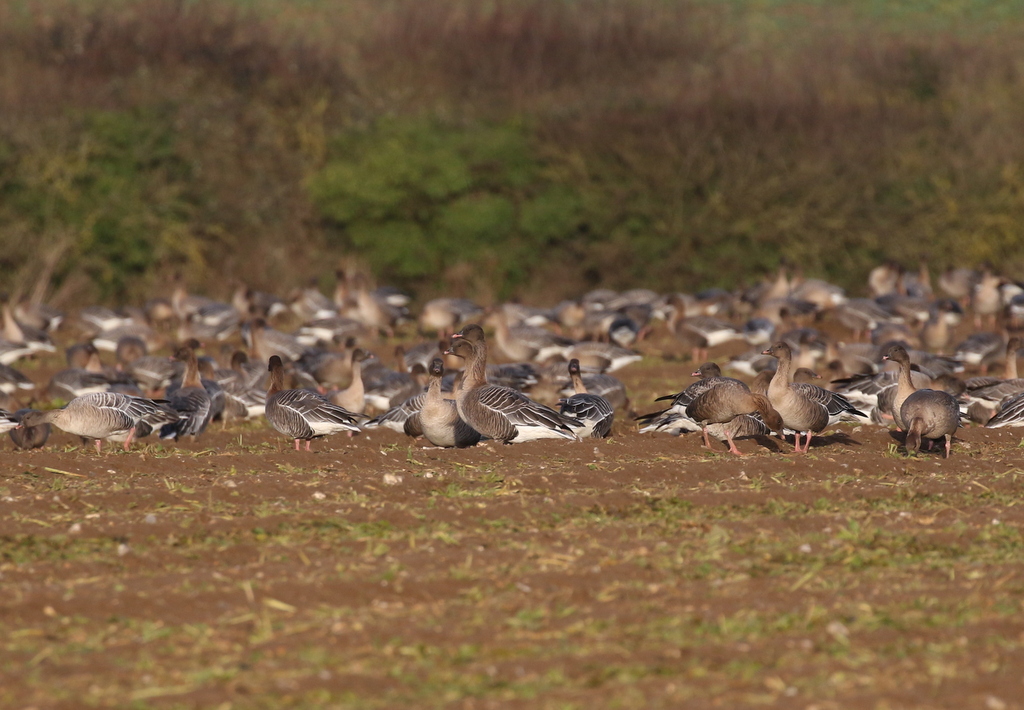
We could only see part of the flock from the top of the field, but we managed to find a single Barnacle Goose in with them. We had hoped to find the presumed Grey-bellied Brant or one or two Tundra Bean Geese which have been seen here recently. We found a couple of birds with orange legs, which would often indicate a Bean Goose, but these were just orange-legged Pink-footed Geese, a variant which is found in small numbers within the wintering flocks here. A Red Kite hung in the air over the woods beyond.
Some people were viewing the flock from the minor road the other side of the field and would have a better view of the whole flock, so we drove round. But it was looking into the sun from here and there was nowhere to park. We asked whether they had seen anything, but they seemed to have not seen anything more than we had. As we drove back through Fring and up towards Docking, a Grey Partridge was in the field right next to the road.
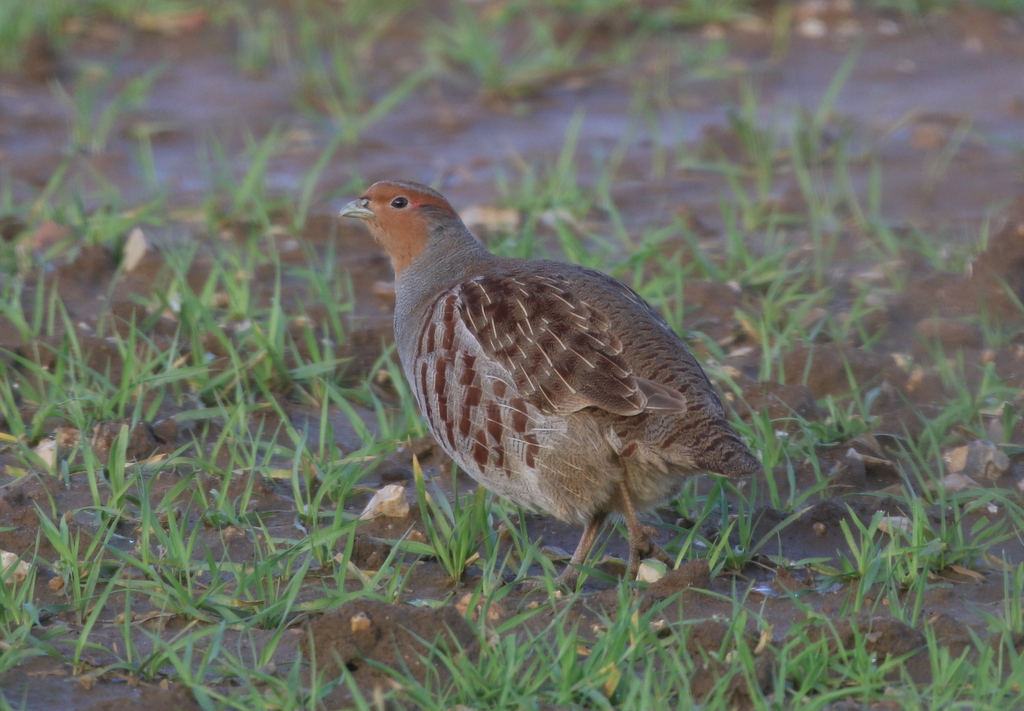
Winding our way up to the coast, we stopped next at Thornham. We had hoped to have a quick look for the Twite here, but we were told they had flown off over the seawall and out onto the grazing marsh beyond a little earlier. We walked round and up onto the bank, but there was no sign of them.
There was a nice selection of waders out in the harbour. Several Common Redshank and Curlew were feeding in the muddy channels closer to the path. Further out, on the flats, there were lots of Grey Plover and a few Oystercatchers. In the main harbour channel we could see little groups of Bar-tailed Godwit, Dunlin and Knot, and some Turnstone feeding along the edge of the water.
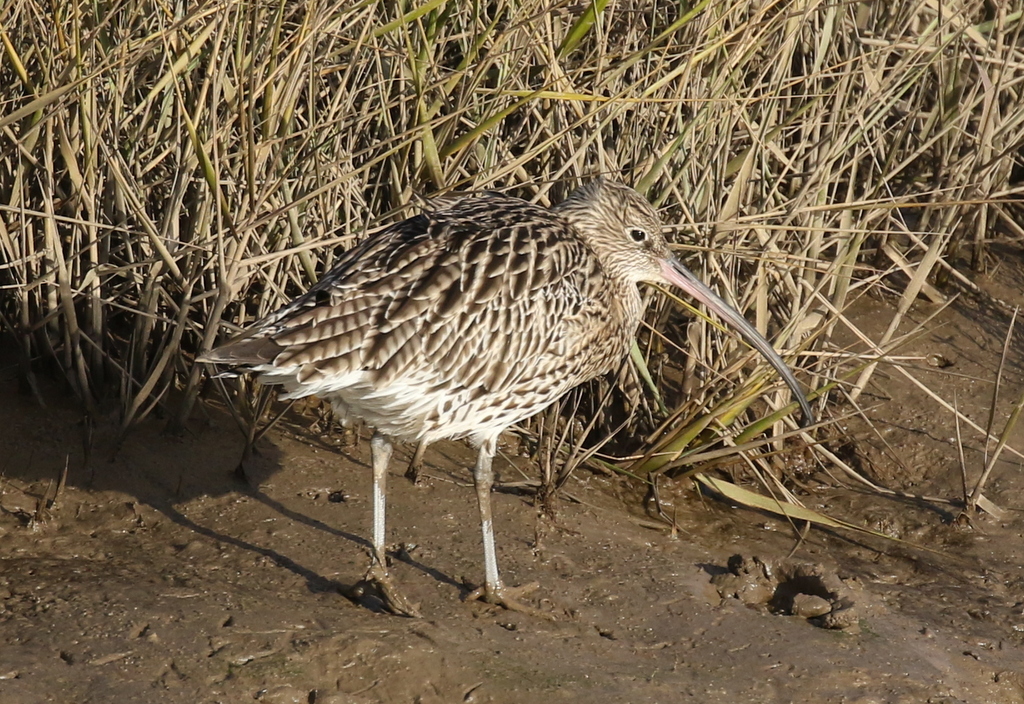
As we walked out along the seawall, we caught a glimpse of a small flock of finches which were feeding on the edge of the saltmarsh. There seemed to be about ten of them (which was the right number for the Twite), but when we got closer we realised it was actually a much larger flock and they were Linnets. A Stonechat was perched on some low vegetation just behind them. Scanning the grazing marshes the other side, we found a good number of Golden Plover roosting in the grass.
At this point, a message came through to say the Waxwing, first seen yesterday, was still at Holme. It was not far, we could see the bird observatory from where we were standing, so we walked straight over. Unfortunately, it turned out that the Waxwing had actually been seen earlier in the morning and had then flown off into the trees. There was no sign now – it later turned out it had flown off all the way to the village. There were a couple of Greenfinches feeding in the rosehips and a selection of tits and a couple of Goldcrests in the pines.
We decided not to hang around and walked back to Thornham Harbour. On the way, a Sparrowhawk flew in low from the saltmarsh and over the bank in front of us. There was still no sign of any Twite on the way back, so we headed round to Titchwell.
The car park at Titchwell was very busy – the reserve is getting so popular, the RSPB needs to make a bigger one! There had been a Woodcock earlier along Meadow Trail, but we couldn’t find it now. It had moved from where it had been, so perhaps it had been disturbed by the passage of people along the path.
When we got out to the Freshmarsh, we found that it was completely flooded with water. Although the water level is always high at this time of year, apparently there has been a problem with the sluice which means there is no way to let water off. The recent rain had topped it up. There were just a few ducks on here today, lots of Teal around the margins, and a group of Mallard and Gadwall tucked in along the edge of the reeds.
As we walked past Volunteer Marsh, a couple of Redshank were feeding in the channel below the path, but there were more waders in the muddy channel along the far side, a few Grey Plovers, Curlews, more Redshank and a couple of Knot.
We were more interested in the waders on the Tidal Pools, which are now tidal again and consequently attracting many more birds. A quick scan revealed two Greenshank roosting towards the back. A Spotted Redshank was busy feeding along the edge, sweeping its bill quickly from side to side in the water. There were a couple of Ringed Plovers right at back, as well as one or two Bar-tailed Godwits. A larger group of Bar-tailed Godwits was roosting on the spit a little further up, along with a lone, hardy Avocet on the end.
There were several ducks out on the water here, mainly Mallard and Shoveler. A small group of Pintail was busily upending in with them, including a couple of smart drakes. There are several Little Grebes on here now, enjoying the new, reduced water levels.
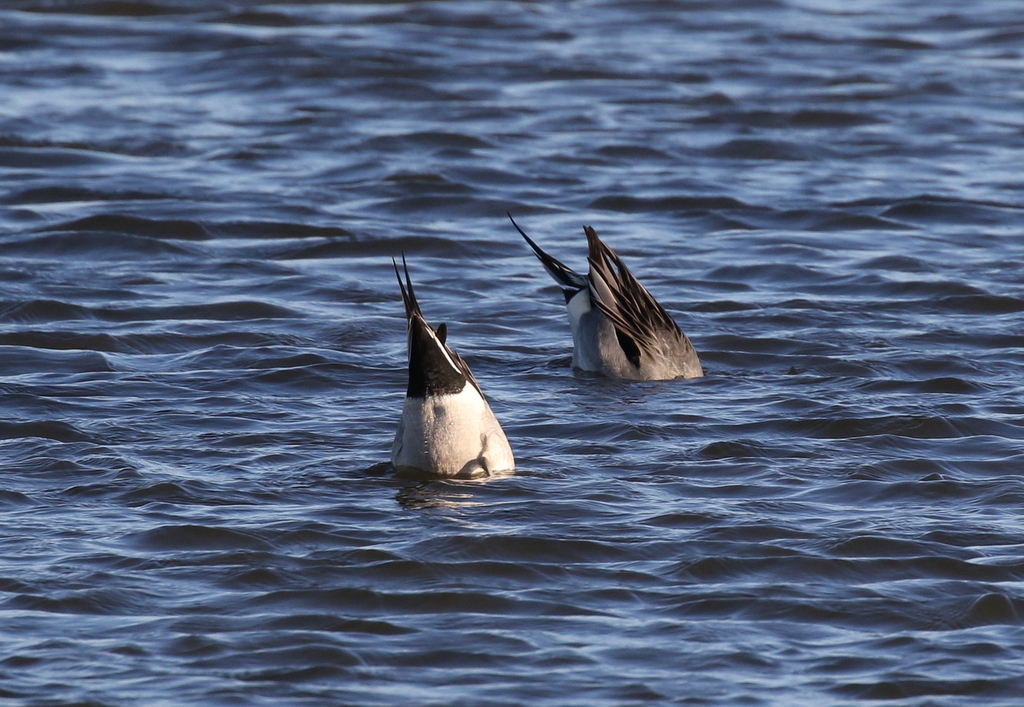
Out at the beach, the tide was in. So there weren’t many waders – just a couple of Sanderling along the shoreline. The sea was rather choppy today. We had a quick scan, and picked up a very distant group of Eider, the white males occasionally catching the light as they bobbed up on the waves. Otherwise, there were several Goldeneye, lots of Great Crested Grebes and a couple of Red-throated Divers which flew past.
As we walked quickly back, we could see a small crowd gathered on the path in the trees. A Water Rail was feeding down in the ditch just below the path. We tried out luck again and cut round via Meadow Trail back to the Vistor Centre, but there was still no further sign of the Woodcock.
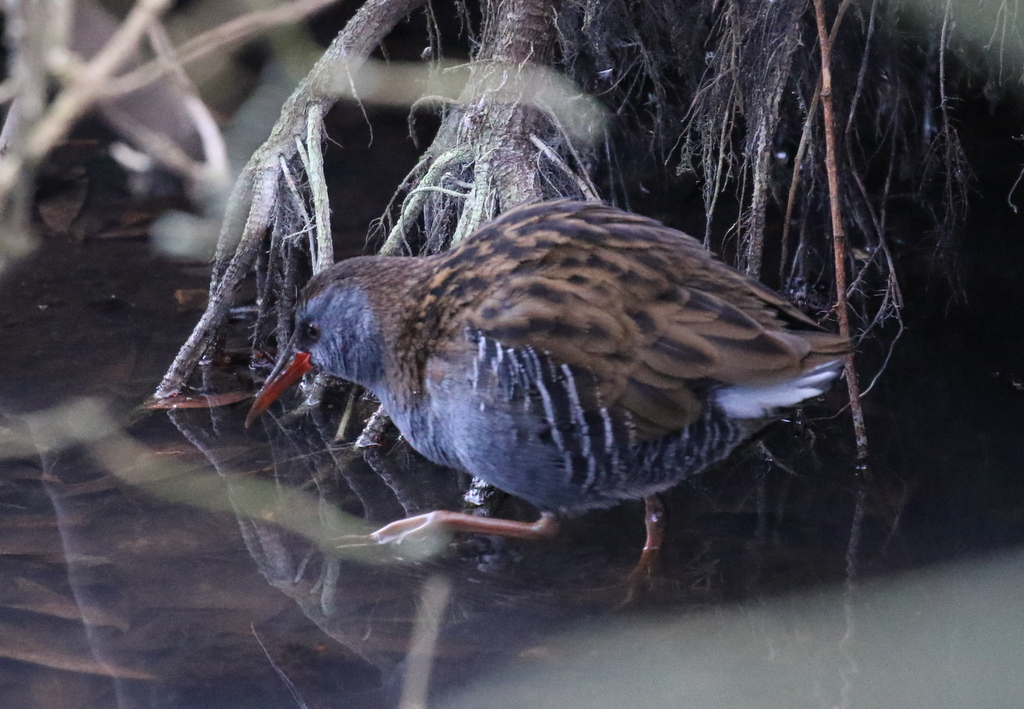
The presumed Grey-bellied Brant had appeared at Choseley in with a big feeding flock of Pink-footed Geese just after we arrived at Titchwell, but by the time we got up there next, all the geese had been flushed by two low-flying helicopters. A few Pink-footed Geese had landed back in the field, but we could see thousands more in the skies beyond, over towards Docking. They appeared to be heading off towards Fring (and sure enough, the Grey-bellied Brant was seen again there later).
We headed back east. A quick stop at the layby at Burnham Overy Staithe produced a distant Great White Egret out on the grazing marshes and several Black-tailed Godwits. A large flock of Golden Plover flew up and circled round in a tight group. A big group of Barnacle Geese flew round too and landed back down on the grass behind the reeds.
Another quick stop further on at Holkham got us a couple of White-fronted Geese on the grazing marshes here, along with a pair of Canada Geese (another one for the day’s list!). There were two more Great White Egrets here too.
The coast was very busy again today. When we got to Wells, there was nowhere to park at the layby. We had a quick scan from the minibus and could see the Rough-legged Buzzard on one of its favoured bushes. So we hopped out, and got it the in scope quickly. We could see its very pale head contrasting with its dark, blackish-brown belly.
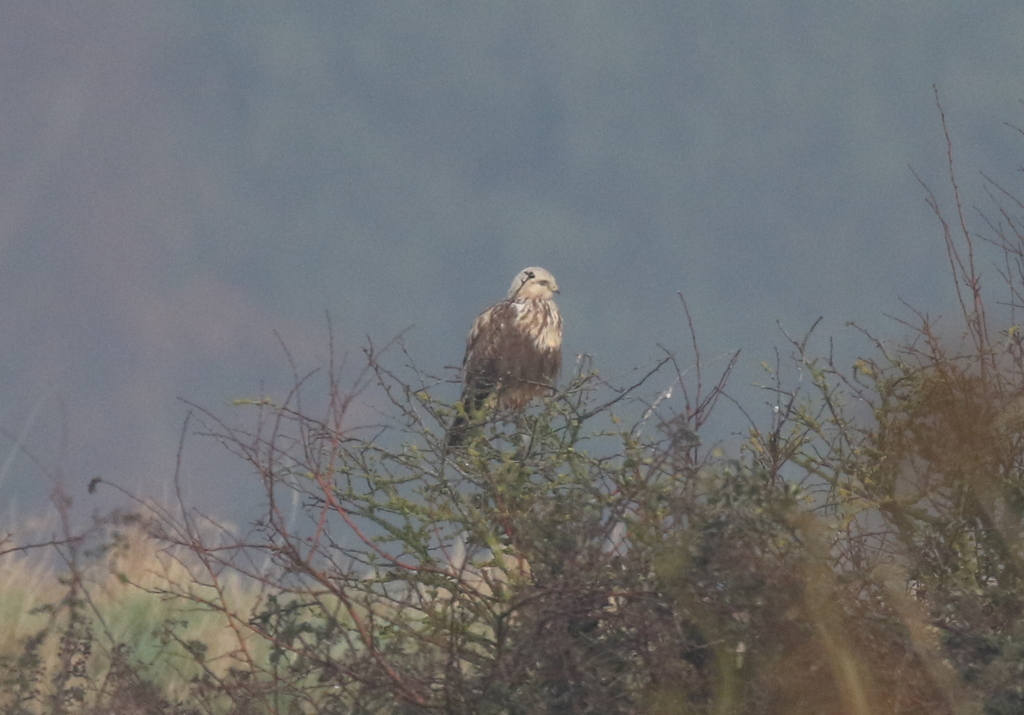
Back to Holkham, and we managed to park on Lady Anne’s Drive, despite it being very busy again. There were lots of Wigeon feeding out on the grazing marshes. A large flock of Brent Geese flew in and landed but were spooked again almost immediately. Several Ruff appeared in the grass with them when they landed too.
Out through the pines and we walked quickly east to the cordon. There were a few people gathered by the rope who got us straight onto the Shorelarks. They were well hidden today, feeding in the denser, taller vegetation. We couldn’t see how many there were, but a head would come up occasionally and we could see a bright yellow face with black mask. A large flock of Snow Buntings was feeding on the shorter vegetation further back in the cordon beyond.
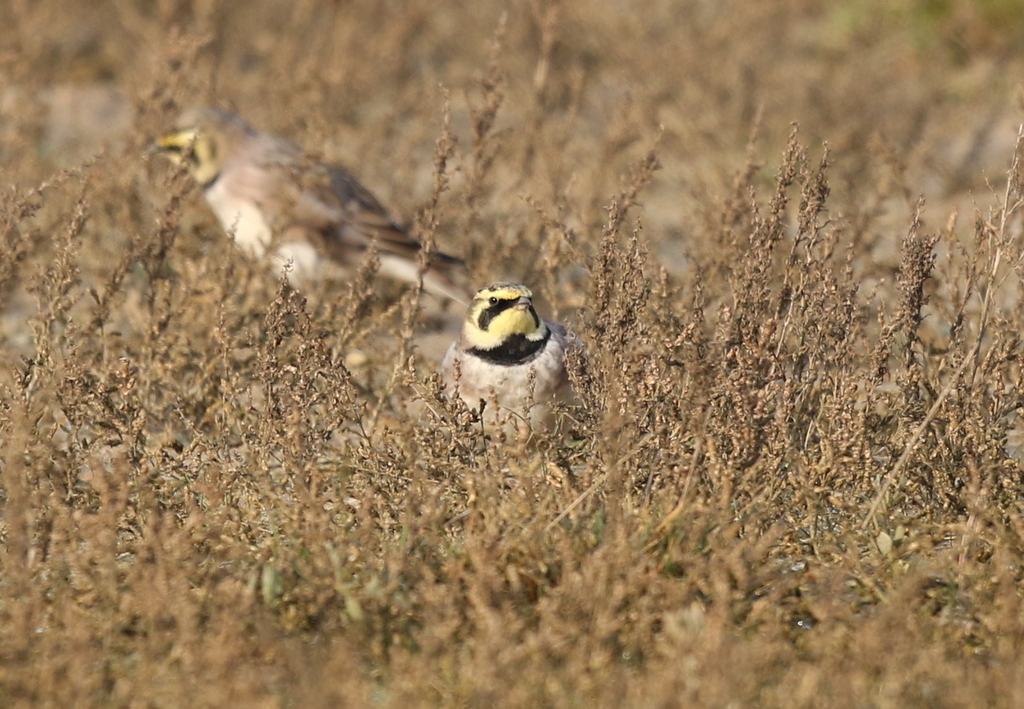
Continuing on up onto the dunes, we scanned the sea. The ducks were further out today, the sea was very choppy here too, but we could see a large black slick of about 4,000 scoter. They were mainly Common Scoter, and it was hard initially to see anything else in with them today. Thankfully they started to take off. They only flew a short distance in several groups, but as the flocks took off we could see several birds with white in their wings. We counted at least 6 Velvet Scoters in this way. There were several Red-breasted Mergansers offshore here too.
It was a bit of a whistestop visit to Holkham today, as we were running out of time. As we hurried back to Lady Anne’s Drive, a Rock Pipit flew over the saltmarsh calling. We wanted to squeeze in one last stop this afternoon, but the days are short at this time of year and we were already a little later than planned. We drove straight round to Warham Greens and walked quickly down to the edge of the saltmarsh. There was an unusually large crowd here today too, but we managed to find a spot to stand and put up our scopes.
A grey male Hen Harrier was already perched out on the saltmarsh – we could see it in the scope. A ringtail Hen Harrier flew east just beyond it and a short while later, either the same or another ringtail flew back west closer in. We watched as it headed out towards East Hills, making the most of the fading light for a last bit of hunting.
A Merlin flew in low and fast and landed out on the back of saltmarsh. They are so small, with the light fading it was hard to pick up when it was stationary, perched down on a low bush. We managed to get that in the scope too. Another ringtail Hen Harrier came up from the ground – this one definitely different, as the other one was still off towards Wells.
There had been a Short-eared Owl seen before we arrived, but it had dropped down onto the ground out of view. Thankfully it reappeared just as the light was going, and flew round over the saltmarsh before landing on a bush.
The Short-eared Owl made for a nice set of birds at the roost today. Unfortunately, with a long journey ahead, we had to call it a day and head back now.
















